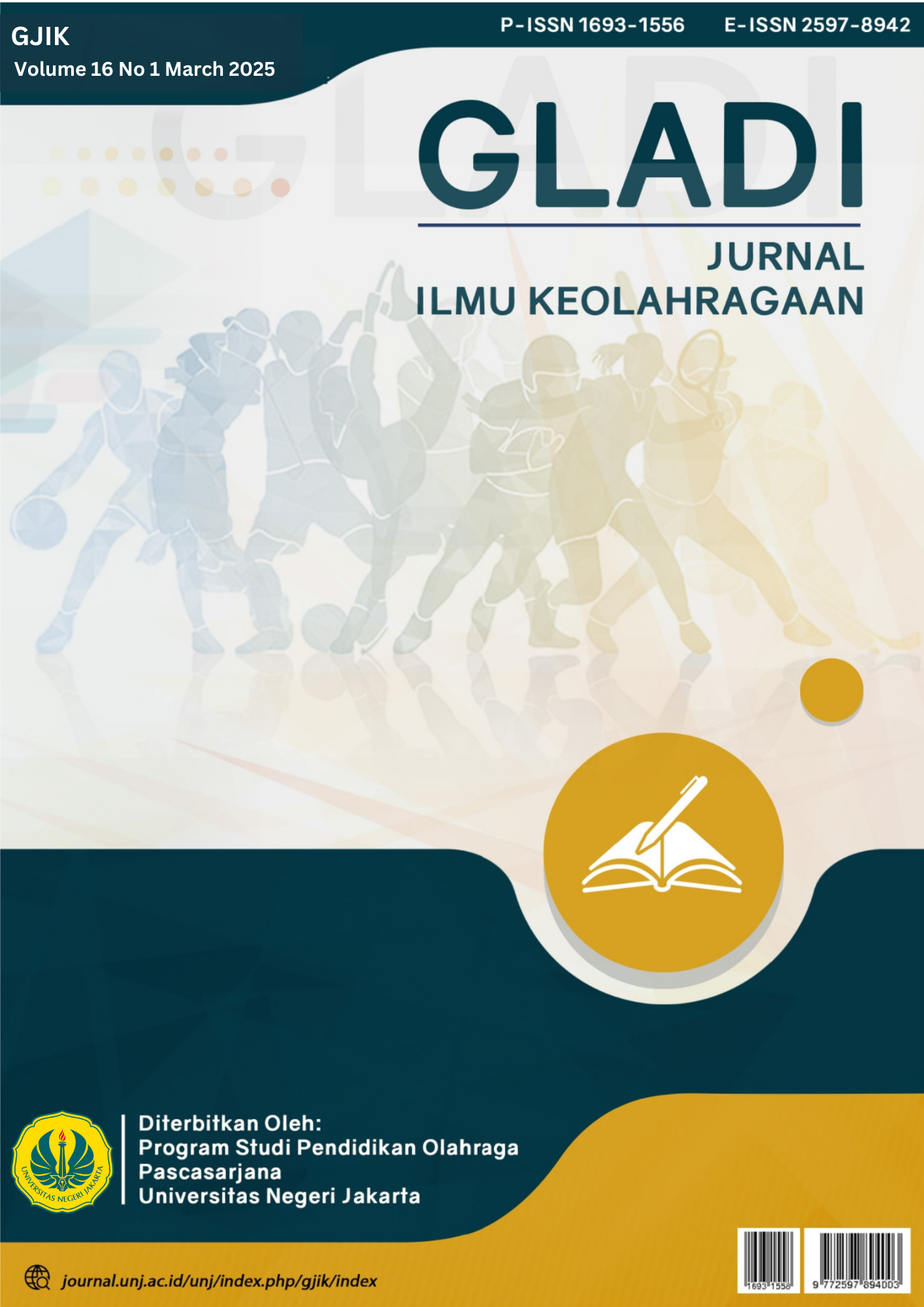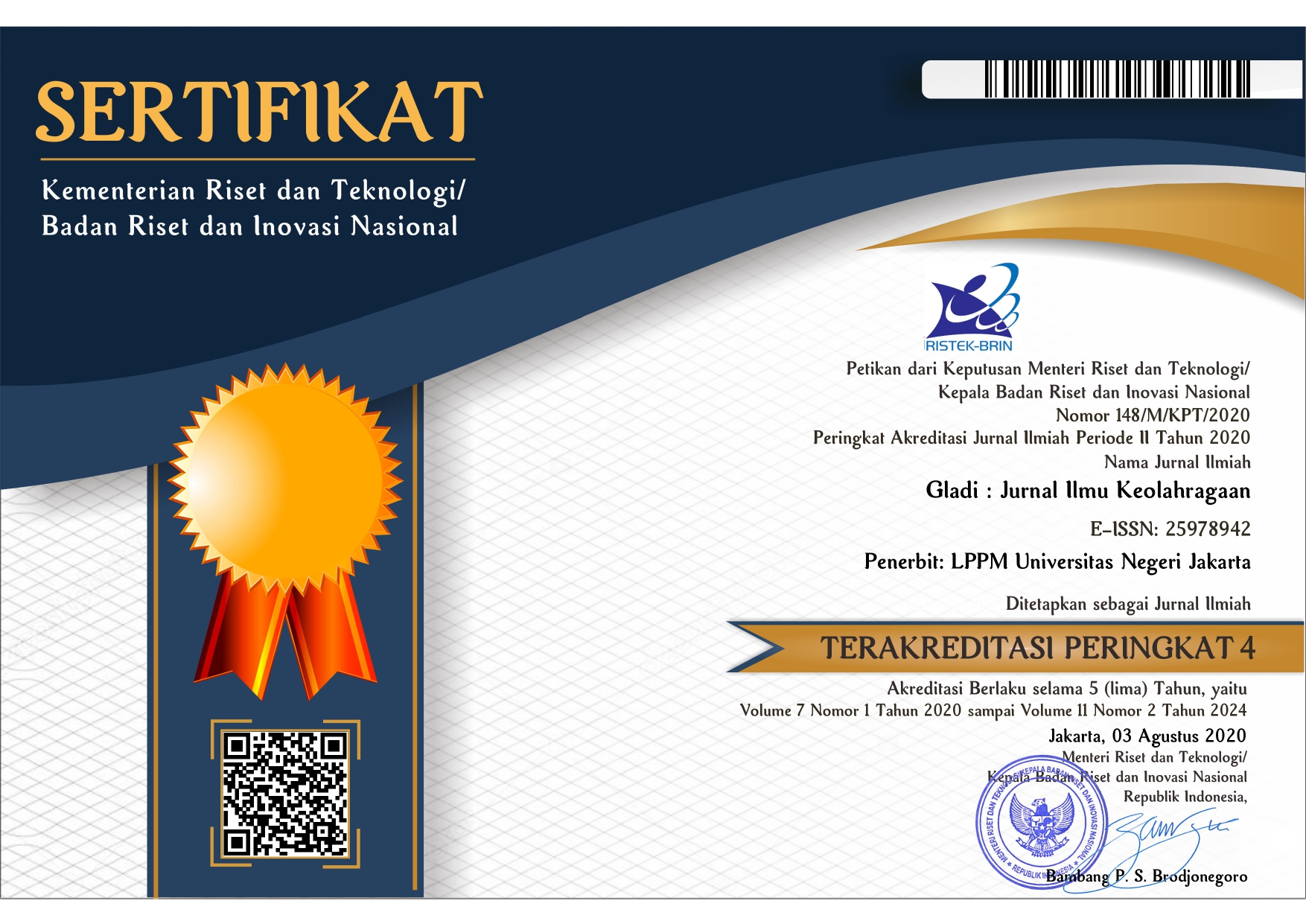VALIDITY AND RELIABILITY OF THE INDONESIAN VERSION OF THE INTERNATIONAL PHYSICAL ACTIVITY QUESTIONNAIRE AMONG STUDENTS: A CONFIRMATORY ANALYSIS USING THE ACTIGRAPH GT3X+ ACCELEROMETER
DOI:
https://doi.org/10.21009/GJIK.161.03Keywords:
IPAQ, Validity, Reliability, Physical ActivityAbstract
Questionnaires and accelerometers are the most commonly used instruments by researchers to analyze physical activity. This study aims to evaluate the relationship between physical activity measurements using two methods: the International Physical Activity Questionnaire (IPAQ) and the Actigraph GT3X+ device. The study sample consisted of 27 male and 23 female students from Universitas Pendidikan Indonesia. The instruments utilized in the research were the Actigraph GT3X+ accelerometer and the IPAQ. Data analysis was conducted by correlating the data obtained from the IPAQ and the Actigraph GT3X+. The results indicated that there was no correlation between IPAQ and Actigraph GT3X+ across various physical activity intensities. Further analysis is required, considering an increased sample size and minimizing self-reporting biases through a more structured approach to achieve more accurate results.
Downloads
References
Ács, P., Betlehem, J., Oláh, A., Bergier, B., Morvay-Sey, K., Makai, A., & Prémusz, V. (2020). Cross-cultural adaptation and validation of the Global Physical Activity Questionnaire among healthy Hungarian adults. BMC Public Health, 20(Suppl 1), 1–10. https://doi.org/10.1186/s12889-020-08477-z
Ahmad, M. H., Salleh, R., Mohamad Nor, N. S., Baharuddin, A., Rodzlan Hasani, W. S., Omar, A., Jamil, A. T., Appukutty, M., Wan Muda, W. A. M., & Aris, T. (2018). Comparison between self-reported physical activity (IPAQ-SF) and pedometer among overweight and obese women in the MyBFF@home study. BMC Women’s Health, 18(Suppl 1). https://doi.org/10.1186/s12905-018-0599-8
Anggunadi, A., & Sutarina, N. (2017). Manfaat Accelerometer Dalam Pengukuran Aktivitas Fisik. Jorpres (Jurnal Olahraga Prestasi), 13(1), 10–33. https://doi.org/10.21831/jorpres.v13i1.12881
Bull, F. C., Al-Ansari, S. S., Biddle, S., Borodulin, K., Buman, M. P., Cardon, G., Carty, C., Chaput, J. P., Chastin, S., Chou, R., Dempsey, P. C., Dipietro, L., Ekelund, U., Firth, J., Friedenreich, C. M., Garcia, L., Gichu, M., Jago, R., Katzmarzyk, P. T., … Willumsen, J. F. (2020). World Health Organization 2020 guidelines on physical activity and sedentary behaviour. British Journal of Sports Medicine, 54(24), 1451–1462. https://doi.org/10.1136/bjsports-2020-102955
Cardon, G., Bergmeir, C., Ruiz, J. R., Lucia, A., & Garatachea, N. (2013). International Journal of Sports Medicine Volume 35 issue 11 2014 [doi 10.1055_s-0033-1363985] Pareja-Blanco, F.; RodrÃguez-Rosell, D.; Sánchez-Medina,.pdf. 975–982.
Cleland, C., Ferguson, S., Ellis, G., & Hunter, R. F. (2018). Validity of the International Physical Activity Questionnaire (IPAQ) for assessing moderate-to-vigorous physical activity and sedentary behaviour of older adults in the United Kingdom. BMC Medical Research Methodology, 18(1), 1–12. https://doi.org/10.1186/s12874-018-0642-3
Craig, C. L., Marshall, A. L., Sjöström, M., Bauman, A. E., Booth, M. L., Ainsworth, B. E., Pratt, M., Ekelund, U., Yngve, A., Sallis, J. F., & Oja, P. (2003). International physical activity questionnaire: 12-Country reliability and validity. Medicine and Science in Sports and Exercise, 35(8), 1381–1395. https://doi.org/10.1249/01.MSS.0000078924.61453.FB
Dharmansyah, D., & Budiana, D. (2021). Indonesian Adaptation of The International Physical Activity Questionnaire (IPAQ): Psychometric Properties. Jurnal Pendidikan Keperawatan Indonesia, 7(2), 159–163. https://doi.org/10.17509/jpki.v7i2.39351
Handayani, F., & Fithroni, H. (2017). AKHIR FAKULTAS ILMU OLAHRAGA UNIVERSITAS NEGERI SURABAYA Fitri Handayani Hijrin Fithroni. Jurnal Kesehatan Olahraga, 10(03), 131–138.
Haskell, W. L., & Kiernan, M. (2000). Methodologic issues in measuring physical activity and physical fitness when evaluating the role of dietary supplements for physically active people. American Journal of Clinical Nutrition, 72(2 SUPPL.). https://doi.org/10.1093/ajcn/72.2.541s
Henry, C. (2005). Basal metabolic rate studies in humans: measurement and development of new equations. Public Health Nutrition, 8(7a), 1133–1152. https://doi.org/10.1079/phn2005801
Hills, A. P., Mokhtar, N., & Byrne, N. M. (2014). Assessment of Physical Activity and Energy Expenditure: An Overview of Objective Measures. Frontiers in Nutrition, 1(June), 1–16. https://doi.org/10.3389/fnut.2014.00005
Lavelle, G., Noorkoiv, M., Theis, N., Korff, T., Kilbride, C., Baltzopoulos, V., Shortland, A., Levin, W., & Ryan, J. M. (2020). Validity of the International Physical Activity Questionnaire Short Form (IPAQ-SF) as a measure of physical activity (PA) in young people with cerebral palsy: A cross-sectional study. Physiotherapy (United Kingdom), 107, 209–215. https://doi.org/10.1016/j.physio.2019.08.013
Lee, P. H., Macfarlane, D. J., Lam, T., & Stewart, S. M. (2011). Validity of the international physical activity questionnaire short form (abstract). International Journal of Behavioral Nutrition and Physical Activity, 8(115), 1–11.
Mazzoni, A. S., Nordin, K., Berntsen, S., Demmelmaier, I., & Igelström, H. (2017). Comparison between logbook-reported and objectively-assessed physical activity and sedentary time in breast cancer patients: An agreement study. BMC Sports Science, Medicine and Rehabilitation, 9(1), 1–9. https://doi.org/10.1186/s13102-017-0072-2
Meh, K., Jurak, G., Sorić, M., Rocha, P., & Sember, V. (2021). Validity and reliability of ipaq‐sf and gpaq for assessing sedentary behaviour in adults in the european union: A systematic review and meta‐analysis. International Journal of Environmental Research and Public Health, 18(9). https://doi.org/10.3390/ijerph18094602
Ottevaere, C., Huybrechts, I., De Bourdeaudhuij, I., Sjöström, M., Ruiz, J. R., Ortega, F. B., Hagströmer, M., Widhalm, K., Molnár, D., Moreno, L. A., Beghin, L., Kafatos, A., Polito, A., Manios, Y., Mártinez-Gómez, D., & De Henauw, S. (2011). Comparison of the IPAQ-A and Actigraph in relation to VO2max among European adolescents: The HELENA study. Journal of Science and Medicine in Sport, 14(4), 317–324. https://doi.org/10.1016/j.jsams.2011.02.008
Prince, S. A., Adamo, K. B., Hamel, M. E., Hardt, J., Connor Gorber, S., & Tremblay, M. (2008). A comparison of direct versus self-report measures for assessing physical activity in adults: A systematic review. International Journal of Behavioral Nutrition and Physical Activity, 5. https://doi.org/10.1186/1479-5868-5-56
Ratnasari, N. Y. (2019). Upaya pemberian penyuluhan kesehatan tentang diabetes mellitus dan senam kaki diabetik terhadap pengetahuan dan keterampilan masyarakat desa Kedungringin, Wonogiri. Indonesian Journal of Community Services, 1(1), 105. https://doi.org/10.30659/ijocs.1.1.105-115
Rothney, M. P., Schaefer, E. V., Neumann, M. M., Choi, L., & Chen, K. Y. (2008). Validity of physical activity intensity predictions by ActiGraph, actical, and RT3 accelerometers. Obesity, 16(8), 1946–1952. https://doi.org/10.1038/oby.2008.279
Strath, S. J., Kaminsky, L. A., Ainsworth, B. E., Ekelund, U., Freedson, P. S., Gary, R. A., Richardson, C. R., Smith, D. T., & Swartz, A. M. (2013). Guide to the assessment of physical activity: Clinical and research applications: A scientific statement from the American Heart association. Circulation, 128(20), 2259–2279. https://doi.org/10.1161/01.cir.0000435708.67487.da
Suwandi, K., Jajat, J., & Ahmad Hamidi. (2024). Analysis of Types of Physical Activity on Active Elderly Community in Bandung City. Kinestetik : Jurnal Ilmiah Pendidikan Jasmani, 8(1), 22–29. https://doi.org/10.33369/jk.v8i1.31997
Tomioka, K., Iwamoto, J., Saeki, K., & Okamoto, N. (2011). Reliability and validity of the international physical activity questionnaire (IPAQ) in elderly adults: The Fujiwara-kyo study. Journal of Epidemiology, 21(6), 459–465. https://doi.org/10.2188/jea.JE20110003
van de Wiel, H. J., Stuiver, M. M., May, A. M., van Grinsven, S., Aaronson, N. K., Oldenburg, H. S. A., van der Poel, H. G., Koole, S. N., Retèl, V. P., van Harten, W. H., & Groen, W. G. (2021). Effects of and lessons learned from an internet-based physical activity support program (With and without physiotherapist telephone counselling) on physical activity levels of breast and prostate cancer survivors: The pablo randomized controlled trial. Cancers, 13(15), 1–13. https://doi.org/10.3390/cancers13153665
Wandani, S., Suherman, A., Jajat, Sultoni, K., Ruhayati, Y., Damayanti, I., & Rahayu, N. I. (2023). Classifying Physical Activity Levels in Early Childhood Using Actigraph and Machine Learning Method. Indonesian Journal of Sport Management, 3(2), 230–241. https://doi.org/10.31949/ijsm.v3i2.7173
Downloads
Published
How to Cite
Issue
Section
License
Copyright (c) 2025 Muhammad Syagil Akbar, Jajat Jajat, Kuston Sultoni, Yati Ruhayati, Adang Suherman, Widy Dewi Nuryanti

This work is licensed under a Creative Commons Attribution-ShareAlike 4.0 International License.







